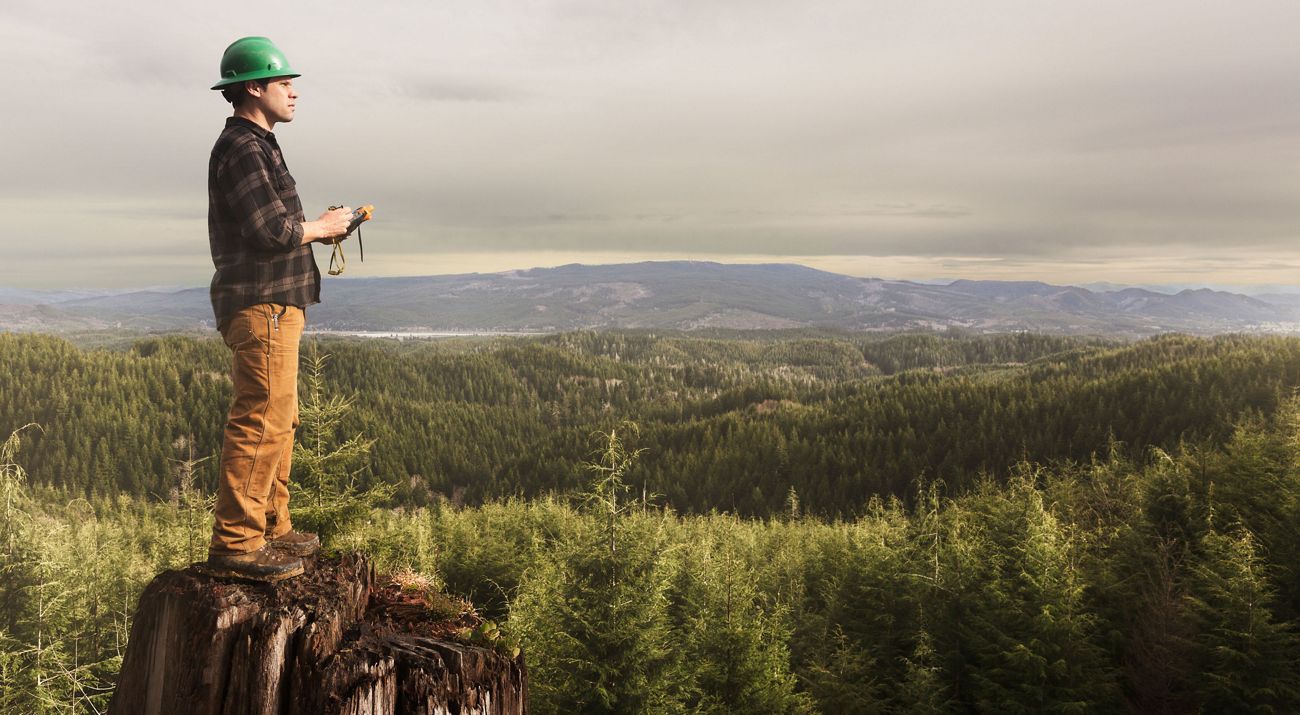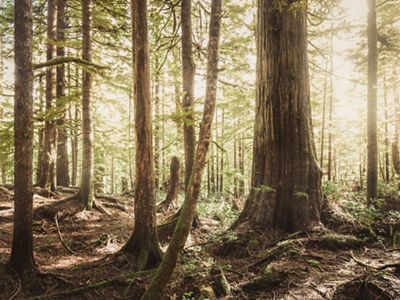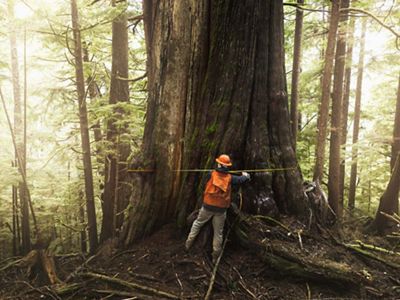
Beyond the Timber Wars
At Washington’s Ellsworth Creek Preserve, TNC is protecting precious old-growth forest, restoring formerly clear-cut lands—and creating jobs.
August/September 2015
It's a rare mild February morning in southwestern Washington, a place so famous for winter squalls that beachfront hotels here offer storm-watching packages. A few miles inland, project manager Tom Kollasch is following faint elk trails through a stand of coastal rain-forest on The Nature Conservancy’s Ellsworth Creek Preserve.
Shards of sunlight slant through the canopy, illuminating an under-story thick with ferns and deep-green shrub. The ground is damp and spongy with moss. Moss is everywhere, in fact—coating rocks, draped like ragged shawls over thick spruce limbs, colonizing fallen hemlocks that collapse into shreds underfoot.
These few hundred acres of old-growth forest represent a rare glimpse of the region’s ecological past. Washington is logging country, and nearly every forest that isn’t protected for conservation has been harvested at least once in the past century. In the Willapa Hills surrounding the preserve, patches of recent clear-cutting stand out like fresh scars.
In this little oasis, though, some trees have managed to reach old age. Many were already centuries old when Lewis and Clark first glimpsed the Pacific Ocean a few miles away at Cape Disappointment in 1805. Some of the cedars here are more than 1,000 years old. No wonder a few are creaking and groaning plaintively.
A more unexpected sound is the faint rumbling and beeping of heavy equipment in the distance. The surprise is that it is coming from a logging operation on Conservancy land, funded by Conservancy dollars.
“If you want to conserve old-growth in southwest Washington, you have to restore second-growth forest,” explains Kollasch, the Conservancy’s Willapa Program director. There simply isn’t much left that isn’t already protected, so the focus has shifted to restoration. In these parts, even a former clear-cut replanted as a tree farm could eventually return to old-growth conditions. But it will take decades, if not centuries. The logging at Ellsworth is part of a long-term experiment to determine whether that transformation can be accelerated. The hypothesis is that thinning second-growth stands, where trees were often planted close together to achieve timber revenue goals, will more quickly yield a diverse and robust ecosystem instead. In addition, the thinning will be done in a way that provides jobs in an economically depressed region and brings in revenue to help pay for the restoration work.
In the process, the project has forged an unlikely partnership that would have been unthinkable two decades ago. In the 1980s and ’90s, loggers and conservationists squared off on opposite sides of the “timber wars” that erupted across the Pacific Northwest over efforts to save the northern spotted owl from the threat of extinction.
Protecting the owl and other imperiled birds is still part of the plan. Kollasch looks up and points out a big, mossy branch on an ancient tree. It’s the kind of branch favored by the marbled murrelet, he says, which is a critically endangered seabird whose numbers have dwindled—along with its old-growth nesting sites. But at Ellsworth Creek, the plan is not just to save these endangered birds but to restore the whole forest ecosystem. Old-growth forest is important for storing carbon and maintaining water quality throughout the Willapa Bay watershed, home to highly productive salmon, crab and oyster fisheries. Conserving this land will provide both ecological and economic benefits to the entire region.

David Rolph, the Conservancy's director of forest conservation in Washington, never thought he would be in charge of a logging operation. He moved here from Hawaii in 1989 to study spotted owls for the Forest Service, right at the height of the timber wars. He and his federal colleagues drove unmarked cars to avoid conflict while passing through logging towns that declared their disdain for forest protections with signs and bumper stickers reading, “Spotted owls taste like chicken.” Timber com-panies rushed to harvest as much old-growth as possible before a moratorium could be issued.
Rolph joined the staff of the Conservancy’s Washington chapter in 1993. In a few years, his job came to include identifying pristine old-growth forestland to purchase with a $2.5 million gift from the Paul G. Allen Family Foundation. He learned of a stand near Teal Slough in Pacific County that had been championed by a local man named Rex Ziak. Ziak had mailed a photograph of one of the grove’s mas-sive cedars, along with a 38-foot rope representing the tree’s circumference, to the landowner, John Hancock Insurance. The appeal worked. Instead of cutting the giant trees, the company sold the land to the Conservancy, which in turn sold it to the U.S. Fish and Wildlife Service to be added to the Willapa National Wildlife Refuge.
Ziak also introduced Rolph to a 300-acre patch of old-growth in the neighboring hills near Ellsworth Creek. Ziak walked Rolph and a few other Conservancy people into the woods, where they sat amid the ancient trees, discussing their significance. “It wasn’t just the old-growth and the murrelets. We started to talk about the salmon that were in the creek system, and the amphibian diversity,” Rolph says. “The discussion went to: What if we thought about acquiring the entire watershed? Be-cause the old-growth stand, in and of itself, wouldn’t protect those things.”
The idea of buying up both old-growth and neighboring logged-over areas was a major departure from the usual approach of purchasing only pristine lands. “At the time that was sort of outrageous, for The Nature Conservancy to be buying clear-cuts,” Rolph says. But from a landscape perspective, it made sense to stop the cycle of clear-cutting and allow the timberlands to return to natural conditions. Between 1999 and 2003, the Conservancy acquired most of the 8,000 acres that now make up the Ellsworth Creek Preserve.
Rolph and his colleagues assembled a science advisory panel, composed of some of the best thinkers in the major forest disciplines, to create an experimental design at Ells-worth. The panel determined that thinning second-growth stands and removing roads were the two most important variables that could be controlled and compared. Road re-moval is important for reducing runoff that can affect water quality. Thinned stands allow remaining trees to grow bigger and stronger by lowering the competition for resources, and the extra sunlight encourages a thriving understory.

With little experience in restoration logging, Rolph turned to others for guidance, including experts who had pioneered road decommissioning and forest thinning in Northern California’s Redwood National Park. The team also established the Pacific Northwest Coastal Forest Restoration Learning Network to share what they learned with others hoping to do similar work.
Ecologist Liane Davis, who studied restoration and forest thinning at Oregon State University, was hired to conduct baseline surveys throughout the Ellsworth preserve. As a student, she was involved in studies that showed promising results from thinning second-growth forest. Ellsworth would take what she saw in earlier studies to a much larger scale.
To take stock of the forest, Davis led the crew on snorkeling expeditions in streams to count fish, searched for salamanders at the headwaters of creeks, inventoried mosses and plants, and measured the sizes and populations of trees. In one survey of the old-growth forest, they used a crossbow to launch ropes high into the trees so that a researcher could climb up to study moss and insect communities.
“We dug in the leaf litter and found six new species of millipede,” says Kollasch. They also found 12 of 13 possible species of amphibians—among the highest levels of diversity in the state—and relatively healthy salmon runs. “And we’ve only scratched the surface.”
After Davis completed the baseline surveys, the team mapped out the preserve into three experimental plots to study different conservation tactics. In the control plot, the roads and the forest are left alone. The second area employs passive management techniques, where roads are removed but no logging takes place. The third was set up to test active management, where second-growth stands are thinned. This plot has been further divided into different test areas based on the age and makeup of the stands. Older, commercially viable stands are thinned and the timber removed and sold, while younger stands are thinned but with the cut trees left to decompose on the forest floor, where they provide nutri-ents and habitat. The old-growth, naturally, is untouched.

Bumping along the preserve's narrow dirt roads in his pickup, Kyle Smith, the Conservancy’s lead forester at Ellsworth, navigates by numbers spray-painted on trees. “At the ‘one,’ headed for the ‘two,’” he announces into a CB radio—a necessary protocol to warn any logging trucks coming the other way. He points out a portion of the road that collapsed during a recent storm. In addition to removing old logging roads in the treatment areas—which requires contouring hillsides back to their natural grades and planting them with young trees—crews have relocated some essential roads to better locations. Roads on ridges are less likely to fail than those mid-slope, where a road failure can cause a landslide that scours an entire hillside, toppling trees and sending sediment and debris into streams.
The truck continues winding uphill, finally stopping near a cluster of massive machines in the road. The largest of these mechanical beasts is a yarder, which uses a system of cables and guy lines to pull timber out of the woods—sort of like a zip line for logs. Earlier, timber fallers had cut a nar-row corridor through which the logs would be removed.
About 800 feet down the corridor on a steep slope are three men called choker setters, who attach the logs to the yarder’s carriage. Most of the choker setters seem to be in their 20s, and it’s easy to see why: running downhill on slippery, uneven terrain is not only highly aerobic, but killer on the knees. Once the yarder pulls the logs to the road, they are sorted by another machine and loaded onto trucks. De-pending on size, grade and market fluctuations, a truckload of timber could fetch around $1,000.
Before it’s carried off, each load is posted with a ticket that traces its path from the forest through the supply chain. This helps prevent the rare but costly instances of theft and documents that the timber comes from a sustainably harvested source. “A working forest is better than development,” says Smith. “And a sustainable working forest is even better.”
In contrast to the trees in the old-growth stand, many of these logs are small enough to reach your arms around. Most are hemlock, which grows quickly in the wake of clearcutting—crowding out other conifers like cedars and creating a monoculture. “Our goal is to thin the hemlock to promote spruce and cedar,” Smith says. He is the one who writes the prescription for each logging site, specifying how many trees and of what size and type should be cut. And he is in the field most days, making sure the prescription is followed.
The loggers say that the kind of work they are doing at Ellsworth is far more challenging than clear-cutting. Fell-ing a single tree at Ellsworth requires careful planning and aim to avoid damaging the surrounding ones. But the crew members also see the benefits to the land and the long-term survival of their industry. “I like what they’re doing here … it’s still pretty after we’re done,” says Russell Shippey, a veteran timber faller who says he can aim a falling tree ac-curately enough to drive a nail. “If we came in here and did regular logging, there’d be no more work.”
Bryan Penttila, a local timber faller and historian, has a unique perspective on the fraught history between loggers and conservationists. He lives in Naselle, a small logging town with a strong Finnish heritage. “People here think of trees as a crop,” he says. “It’s a very pragmatic idea.” Under this view, the concept of leaving the forest alone would be “like letting cattle die of old age.”
But Penttila, who has written several books on regional logging history, also understands the toll that shortsighted practices have taken on the land. At the Appelo Archives Center, a small museum where he is a founding board mem-ber, Penttila points out a black-and-white photograph from Ellsworth of a truck carrying a single gigantic log. The logging heyday continued through the 1970s. “Then this horrible thing happened here. We ran out of old-growth,” Penttila says. He adds drily, “I don’t know how that happened.”
In the 1980s, the region's forestland was owned primarily by traditional timber companies that had a long-term stake in the communities where they worked, Penttila says. More recently there’s been a proliferation of investment organizations that may log the land for a few years, turn a profit for investors and sell. Meanwhile, adds Kollasch, the length of time between clear-cuts has grown shorter. He notes that one site near Ellsworth was cleared after only 28 years, where the norm used to be at least 40 to 50. “I worry that the increasing frequency of harvesting could lead to boom-bust cycles,” he says.
Providing jobs and continuing to allow recreational access on Conservancy land has helped build trust in com-munities where suspicion of environmentalists can run deep. Kollasch recounts a story from his early days at Ellsworth, when a man in a truck pulled over outside the preserve to talk. “I’m a logger, and you’re just going to lock this up,” barked the man, who was so upset he was shaking. “You people will never be accepted here,” he said.
Kollasch says he laid out the Conservancy’s plans for re-storing Ellsworth, “and by the end of it, he shook my hand.”
Amid the mossy giants, Kollasch stops to admire one of the oldest trees in the stand—a western red cedar about 14 feet in diameter and 175 feet tall. He estimates it could be older than 1,000 years.
It’s a reminder that although humans can help reverse some of the damage they’ve done in the past, ultimately time is the master of this landscape. “These forests are ancient,” says Kollasch. “We can try to accelerate old-growth, but it’s gonna take 600 years to get a 600-year-old tree.”